Log in or Sign up
You are using an out of date browser. It may not display this or other websites correctly. You should upgrade or use an alternative browser .

Lightning Sailboat 19' build
Discussion in ' Boat Design ' started by FirstLight , Aug 21, 2012 .
FirstLight Junior Member
Have always loves this classic design from the board of Sparkman and Stevens. There's a small fleet here in our area. For a winter project I want to build one. There are several sets of offsets with the fast design that I've brought into Rhino. I'm trying to determine what the strongest\lightest build technique would be (no foam) for a one off lightning. Cold molding would seem the answer however the hard chine doesn't seem to fit the process as well. Then there is the frame method the Gougeon boys outline in their big blue bible. Any thoughts or ideas?? Cheers..
gonzo Senior Member
Balsa planks core composite should be the lightest and stiffest. That design was made for carvel construction and has very easy lines.
DCockey Senior Member
FirstLight said: ↑ Have always loves this classic design from the board of Sparkman and Stevens. There's a small fleet here in our area. For a winter project I want to build one. There are several sets of offsets with the fast design that I've brought into Rhino. I'm trying to determine what the strongest\lightest build technique would be (no foam) for a one off lightning. Cold molding would seem the answer however the hard chine doesn't seem to fit the process as well. Then there is the frame method the Gougeon boys outline in their big blue bible. Any thoughts or ideas?? Cheers.. Click to expand...
Petros Senior Member
I would recommend sticking with the rules, if you do not, not only will you not be allowed to sail in the races, it will not have much resale value when you are done with it. It appears there is no advantage to a lightweight build since rules require a 700 lb hull anyway. You might consider finding a used one and refurbish it, it will cost less and get you on the water faster.
tunnels Previous Member
Are you into compatition or just playing about ?? Like has been said buy a second hand boat and refurbish it like new do a 100% strip of all and everything and scrape the paint off and respray etc etc But if the boat has a balsa cored hull you can bet 100% that it will be wet and heavy so theres you chance to do a rebuild rather than start from scratch !! To SAVE IN WEIGHT if you do a rebuild use balsa and what ever glass and then infuse it !!! will never be able to make it any lighter than that , use paints and not gelcoats Pick you glass carefully !!woven glass materials are thicker and so used more resin , differant cloths for differant uses ,also the type of glass ask and choose wisely , use epoxy resin and make sure you speak to the chemist if possible and get the strongest with a little flex . (Not all resins are born equal ). save weight every where possible . there could be raised eyebrows of you under weight but han always screw a lead block ti the middle to bring it to the minimum weight and as the boat gets older get it re weighed and change the lead block ! You not breaking the rules just bending them a little !! But, what do i know !
sonosail SONOSAIL
Lightning class plans About 20 years ago the Lightning class created a new set of plans/rules for plywood contruction. I think one boat boat was built using the WEST system. rb
philSweet Senior Member
They are wonderful boats but you should be aware that some of the top small boat builders in the country have built these things. Expectations for a wooden hulled Lightning will be very high among class members, and not just among the elite racers. The woodies used to have a very slight rules advantage over the glass boats and most of the national champs went with woodies. There is a ballast allowance of twenty pounds on the centerline. Any extra has to be distributed elsewhere. If I recall, the object of the game is to come in exactly twenty pounds light at 680 in measurement trim and then max out the centerline ballast allowance. So basically, you assemble your rig, lines, hardware kit,CB, and rudder and weigh that. Then build the whole thing with temp fasteners and carefully weigh it again. Then take it all apart and put it together permanently after any adjustments allowing for glue and paint and fairing putty. Am I dreaming or were the old hulls all double diagonal planked on the bottom. I used to sail on one until I was five. I soloed it on the Chesapeake. My parents were more than a little annoyed I took the boat out. But all I remember was the fun I had and Mr Keck coming out and asking me to please return to the dock. Then he motored back to the dock and let me sail her in. Mr Keck gets lots of points for letting me do that and not towing me in. I've sailed on them once or twice since then. Keep all of your reciepts and document the build as you go and ask lots of questions of the association members.
sonosail said: ↑ About 20 years ago the Lightning class created a new set of plans/rules for plywood contruction. I think one boat boat was built using the WEST system. rb Click to expand...

- Advertisement:
Old Boat.. Guys.. Great information!!! After looking through the options and debating building from scratch I opted against it. You guys made some good points. Thank you so much. A few weeks back I picked up a 1970's Lightning for $100. I figured I would see if it was worth rebuilding to have some fun with it. I posted a new link since I am down to the outer skin in one section. I am probably crazy for giving this a shot but if all goes bad I'll have about $300 invested and that's all. And if the hull goes away I have a brand new mast, new boom, new spinnaker, good set of practice sails and about $500 in Harken hardware, a trailer in great shape and a SST centerboard. I figured I'd try removing the foam core in one area and stiffening to see what I get. Here is the link. Once again. Any and all information greatly appreciated!!! Here is the link: http://www.boatdesign.net/forums/boat-design/help-repairing-19-lightning-sailboat-44433.html
HELP! Repairing 19' Lightning Sailboat
Lightning Avoidance
Lightning arrester
Older fiberglass Lightning Class Running Rigging
Lightning bottom shape
"Lightning" solar electric sail hybrid concept
Navigating Through Keel Challenges: Seeking Wisdom on Sailboat Redesign
Reversable sailboat?
Reshaping keel of microcup sailboat
42 foot steel round bilge sailboat scantlings
- No, create an account now.
- Yes, my password is:
- Forgot your password?


- Welcome, Guest
- Model Boat Mayhem >
- Mess Deck: General Section >
- Model Boating >
- Building the Lightning sailboat model (by Dumas)
Author Topic: Building the Lightning sailboat model (by Dumas) (Read 1083 times)
- Happy to be a part of this group!
- Location: The rocky coast of Maine, USA
Re: Building the Lightning sailboat model (by Dumas)
- Full Mayhemer
- Posts: 3,357
- Huntingdon, Cambs, England
- Location: Huntingdon, England
derekwarner
- Posts: 9,511
- Location: Wollongong Australia
- Posts: 4,511
- Location: North of Watford, South of Hadrians wall
- Posts: 1,209
- SMF 2.0.19 | SMF © 2011 , Simple Machines | Terms and Policies
Page created in 0.087 seconds with 21 queries.
- - Build logs for subjects built 1901 - Present Day

- Remember me Not recommended on shared computers
Forgot your password?
Lightning Sailboat by Woody S - from Dumas plans
By Woody S March 19, 2022 in - Build logs for subjects built 1901 - Present Day
- Reply to this topic
- Start new topic
Recommended Posts
I have been inspired by Andrew J's Lightning experience building first a Kit and then from scratch.
My children learned to sail in the 1960's on Lightning #5138. I would like to create a model of that sailboat. I have built scratch models of 1850's schooners before. But on this project I decided to take some shortcuts and start with the Dumas plans. The fun will be in the changes in rigging and paint to match the 1960's boat. The parts of the boat that won't be visible will not get much attention. Sorry purists.
Anyway here is a photo of the real boat. And a photo of progress to date. The only changes so far have been to add some interior ribs. The floorboards and seats will be the focus of the interior.
I would love to hear from anyone who can help me find the scale hardware. Also tips on the rigging aand finishes would be most appeciated.
Thanks, Woody
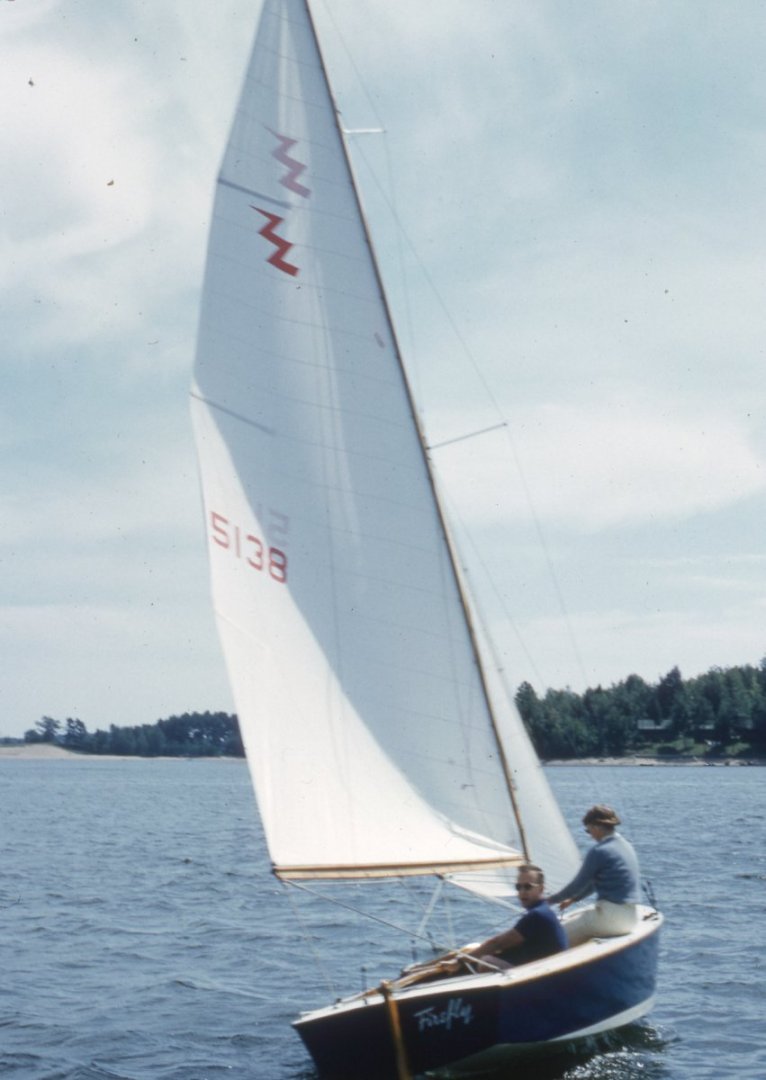
- GrandpaPhil , yvesvidal , Matt D and 2 others

Link to comment
Share on other sites, roger pellett.
A nice suit of sails, beautifully set! 1960’s- I assume that this was still a Woody.
Thanks Roger.
Yes this was a Skaneateles built boat. We sailed it on Sacondaga Reservoir near Schenectady , NY
I just found a nice looking model of #392 on the Gallery here. It looks like he raised the seat level as did I. He also made a nice mast step. I wish I knew where he got the hardware.

A very nice looking sailing dinghy, Woody!
I have been looking at pictures of old Lightnings near # 5138 to try and remember what my cockpit looked like. This morning I mocked up some seats and floorboards. The kit had solid wood for the seats and floorboards, which was not my Skaneatlas design. Also I see that I am going to have to cut away more of the ribs under the deck . I am planning to stain the centerboard trunk mahogany because that is what it was. The ribs were spruce and I am thinking of spruce floorboards as well. Too much dark mahogany for me. My color scheme will be a white deckand bottom and royal blue topsides.
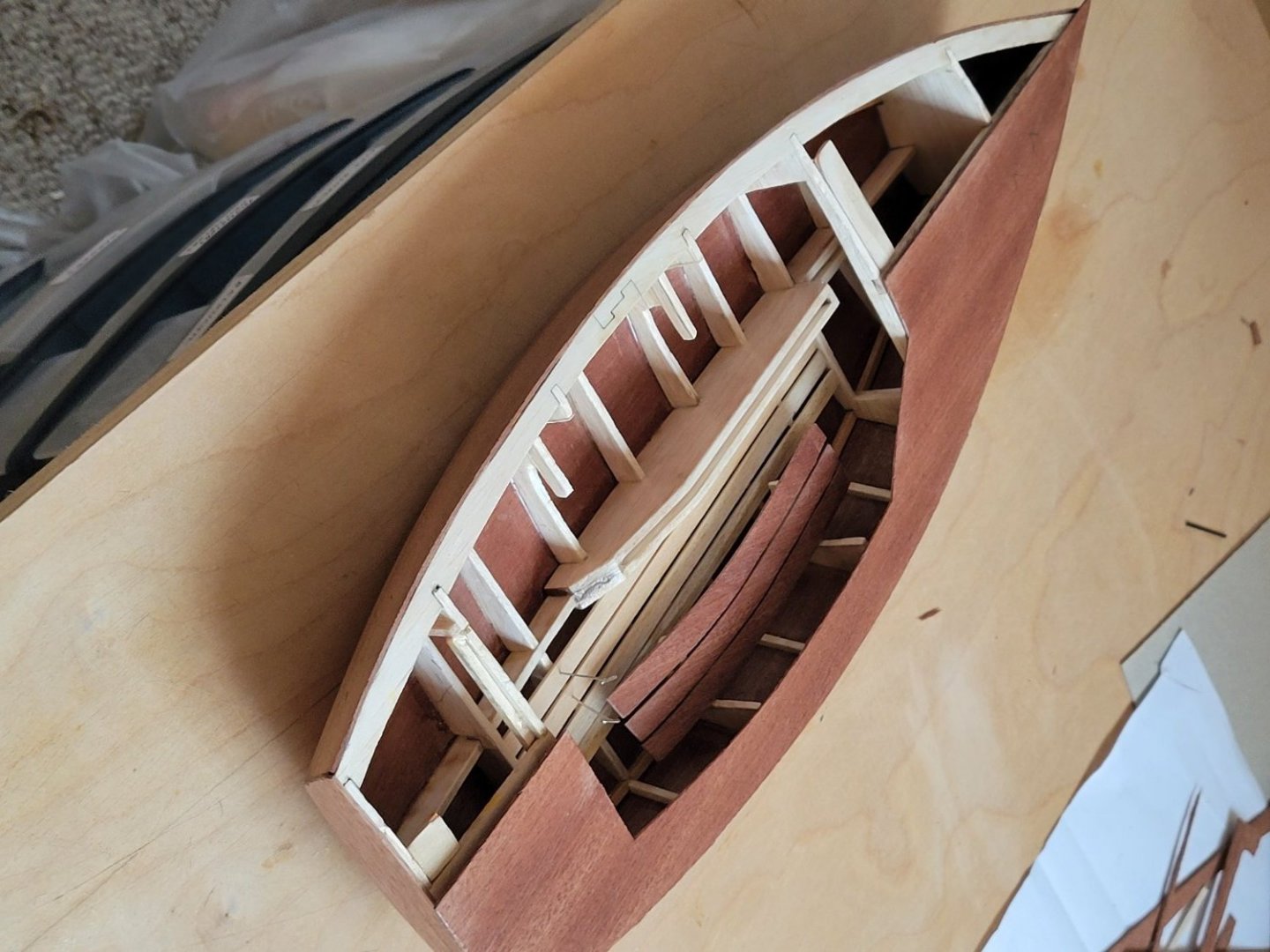
- Roger Pellett , KeithAug , yvesvidal and 1 other
Peter Rumgay
Wow, my father and l built Lighting 7759 in 1966 in our basement. We both shared a great love of sailing
and ship model building. At 91 my father remembered he still had the blue prints of the Lighting and asked me
to built him a model of our boat. I hope you have a much fun building your Lighting as l did because it brought
back such great memories. Cheers, Peter Rumgay
That is interesting. The Lightning was designed by Sparkman & Stevens with home building in mind. But my hat is off to you for doing it.
Do you have a picture of the model or the boat ?
The Lightning class superceded the Star class here in Noroton Bay, CT in the 1940's and I learned to sail as a crew.
Best, Woody
That mock up looks pretty good!
l haven't worked out how to send pictures to MSW yet. I can send you pictures of my model if you
sent me an e-mail [email protected]. My turnbuckles came from a. J. Fisher models with some
modification.Blocks came Cornwall model fittings (England) the corell line of ship model kits. The
stainless wire rigging and halyards which make the model look so good came from Cornwall models
as well. Mast & Boom track is made thin brass rod. I too purchase the Dumas kit but only used it as
guide to build my lighting as the rib sizes were wrong. The block sizes on mine are out , make sure you
scale them properly . You model is really coming along and going to look great.
Wow ! That is so helpful. I can't wait to rsearch those fittings and rigging. I was wondering about the mast track. I was thinking my mast was slotted for the bolt rope of the sail. (easier to do 🙂 ) but I am probably wrong.
PLease do email pictures of your model. Email [email protected]. I just emailed you and hope it goes through. I am looking forward to seeing the details of your boat.
Did receive you e-mail and sent pictures that l Hope help. Lightings of that era had mast
tracks and slides very hard to reproduce at that scale and beyond my skills, that's why l
went thin brass rod with very tiny rings to hold sail.
Cheers Peter
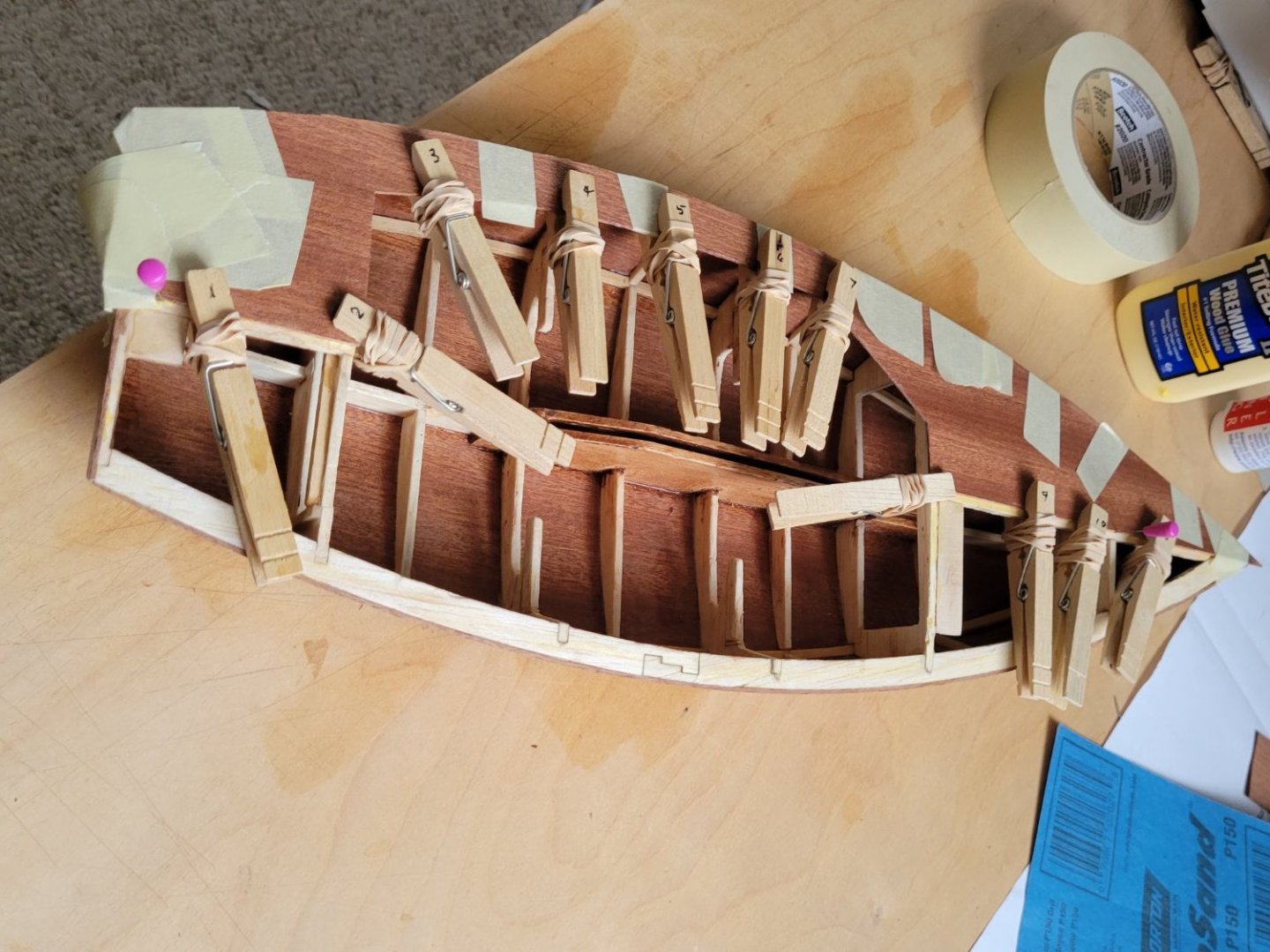
I received your email, but unfortunately no pictures were attached. Maybe it is because I have a PC and you have Apple, but probably it is something else. I don't understand why you can't attach your picture files to your messages here. On the bottom it says " choose files".
Anyway I am in the process of gluing on the deck tonight. (picture)
Your model will be authentic inasmuch as you took the time to build the real frames, and planked it. Mine will not, but I hope that the casual observer will not be able to see the lack of interior detail. If I had had your plans i might have done it. I spent a lot of time trying to turn the Dumas Bass wood centerboard trunk into mahoghany, whereas you probaly made yours out of real mahogany from the start. Anyway I will make a mahoghany rudder.
I am thinking that I will paint the deck before putting on the cockpit coaming and splash boards.
- GrandpaPhil and yvesvidal
Today I worked on the floorboard . Next I will have to make the forward and aft seats and figure out how they were supported. The picture on the left is of a Lightning sailboat of a similar vintage. I can see some more modifications for me to copy that. I wish I could figure out how to rotate these pictures.
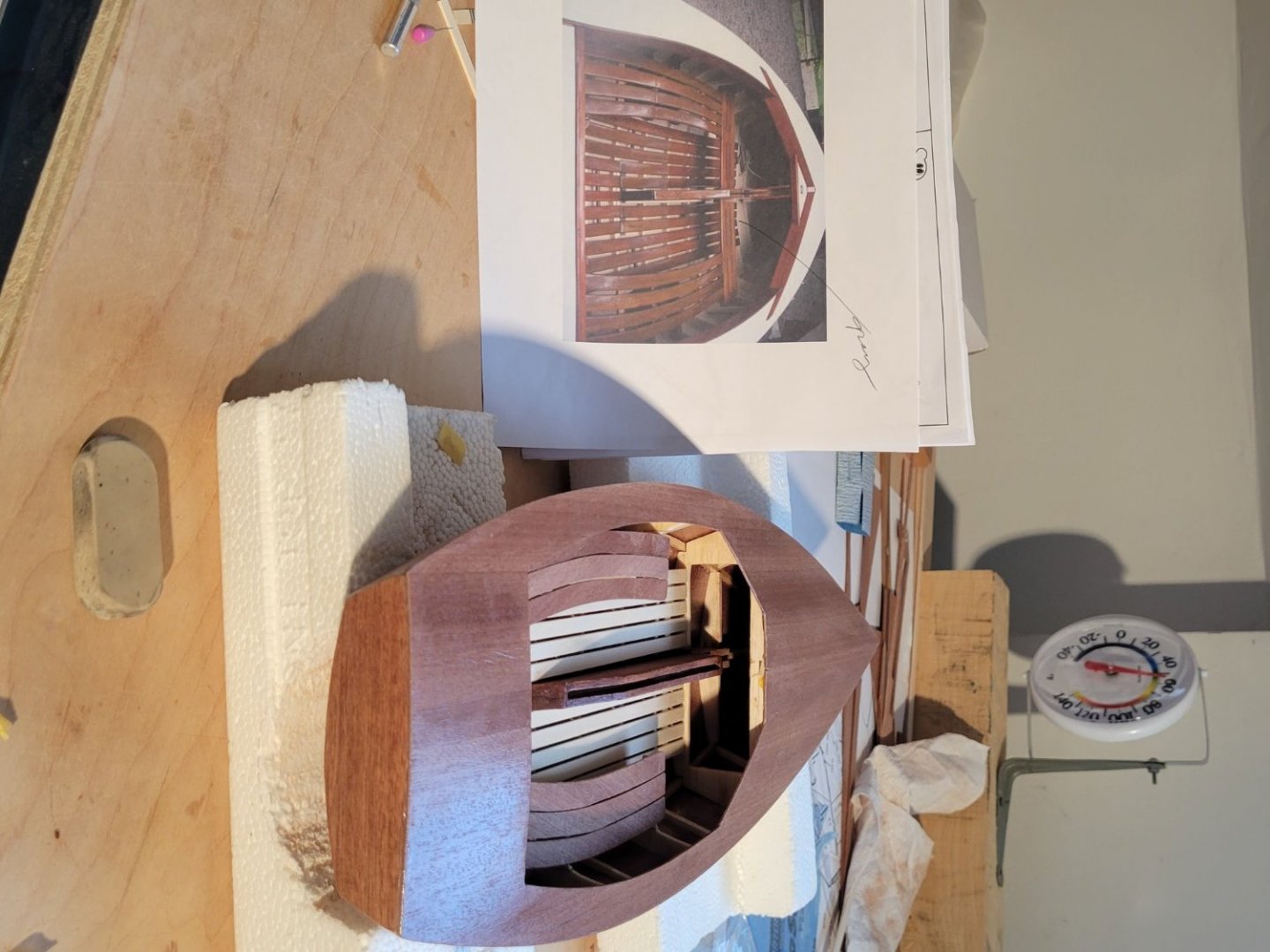
- Paul Le Wol , yvesvidal , wefalck and 2 others
Looking very classy!
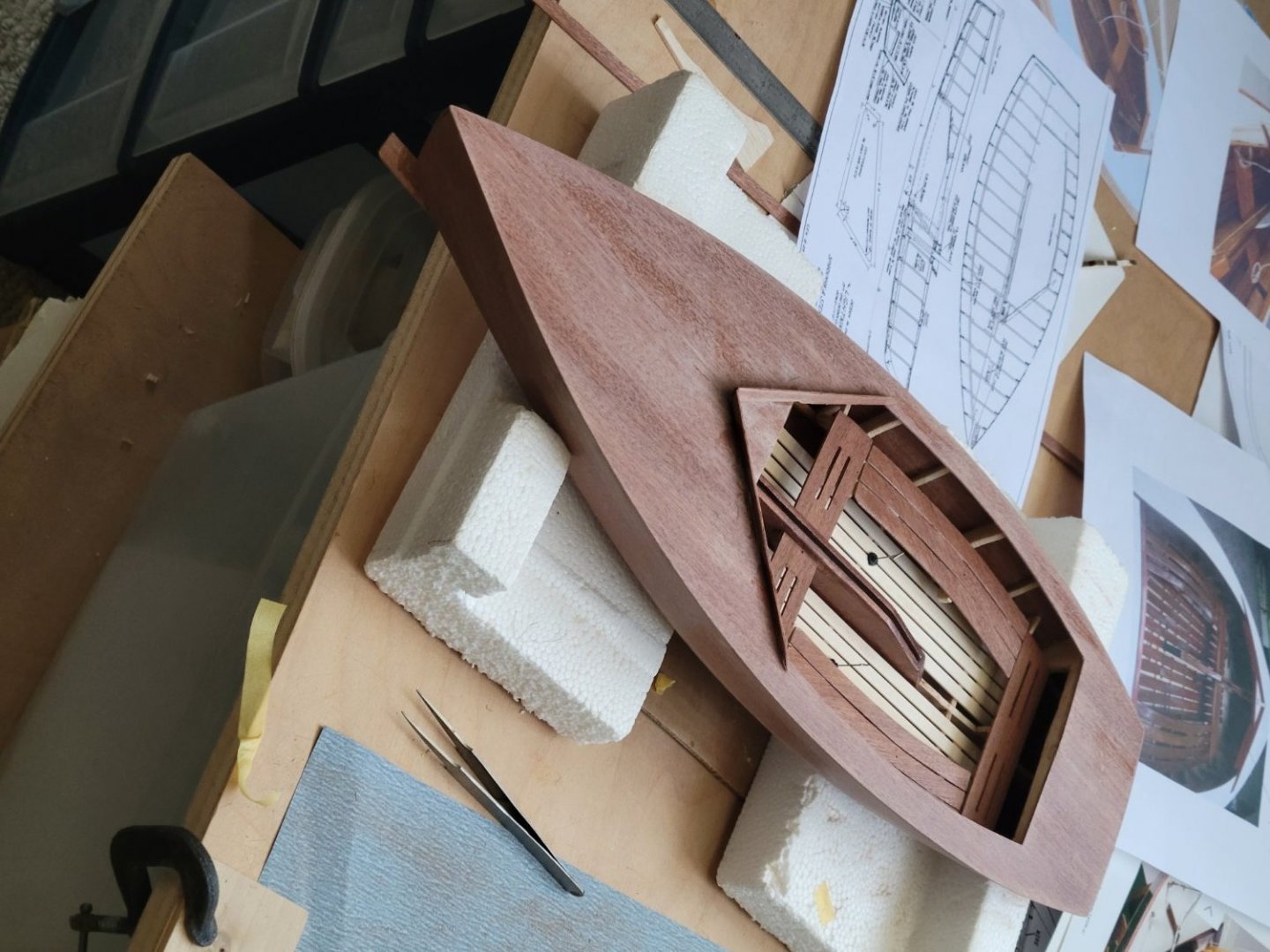
For one I would make the frames out of bass wood instead of the oversize balsa provided. I cut out a lot of the balsa frames but would have liked to do more. The cockpit trim called for on the plans is not correct and is going to take a lot of work to make and fit although I was able to utiilze the mahogany from the kit.
I decided to cut the centerboard slot in the bottom plank before gluing it on. From here on I will have to use research to go forward with cockpit trim , mast step, chainplates, and rigging. This will take happy time.
- Andrew J. , GrandpaPhil , wefalck and 2 others

Wonderful job on the seats and floor boards! I hope to make mine look as good when I get to them.
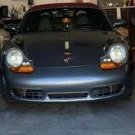
Beautiful job on this boat. I have a kit built version put together after I bought my full scale lighting, a Skaneateles built boat #7592. I sold it 10 years ago, it underwent full restoration and still races competitively on the East Coast and at the Mid-Winters in Tampa every year.
current dry dock USS Arizona
- 4 weeks later...
Thank you Dion and Andrew for your kind remarks.
Especially, coming from Andrew who built his beautiful Lightning hull from scratch . I use the picture of his model for reference. I also got a lot of good info from Peter Rumgays lovely boat.
I am now into the hard part of working without any plans I have scoured the internet trying to find out exactly where the Centerboard spool and reel are located. And how are the jack stays attached to the jumper struts ? I have ordered rigging fittings, stainless steel, working turnbuckles and even a boom vang. It looks like I will have to make brass tangs and chainplates. But it is all good fun. I scrapped the Dumas rudder and centerboard. I am going to make my tiller the same as it was on #5138, split and reinforced with brass. I am going to put the rub rails on last
Cheers, Woody
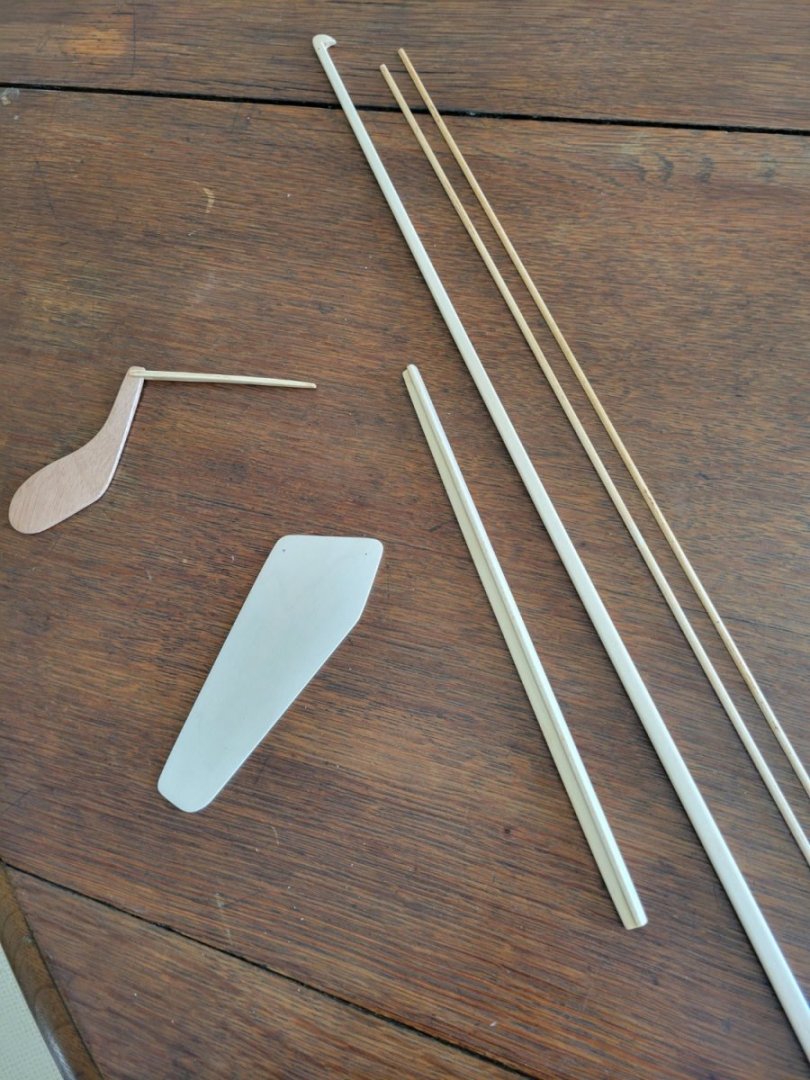
- Roger Pellett , yvesvidal , wefalck and 2 others
- 1 month later...
I have finally finished painting the hull. It took many trys before I got the mirror finish on the topsides. I finally used auto body primer and paint. (many coats).
Putting the rub rails on last was a mistake because the glue got everywhere and I had to sand down and redo.
Now I have the fun of installing the centerboard and its mechanism. Then the mast and rigging.
If anyone knows where I can find realistic jib sheets and main sheet lines ( eg ;braided dacron ) Please let me know.
Thanks , Woody
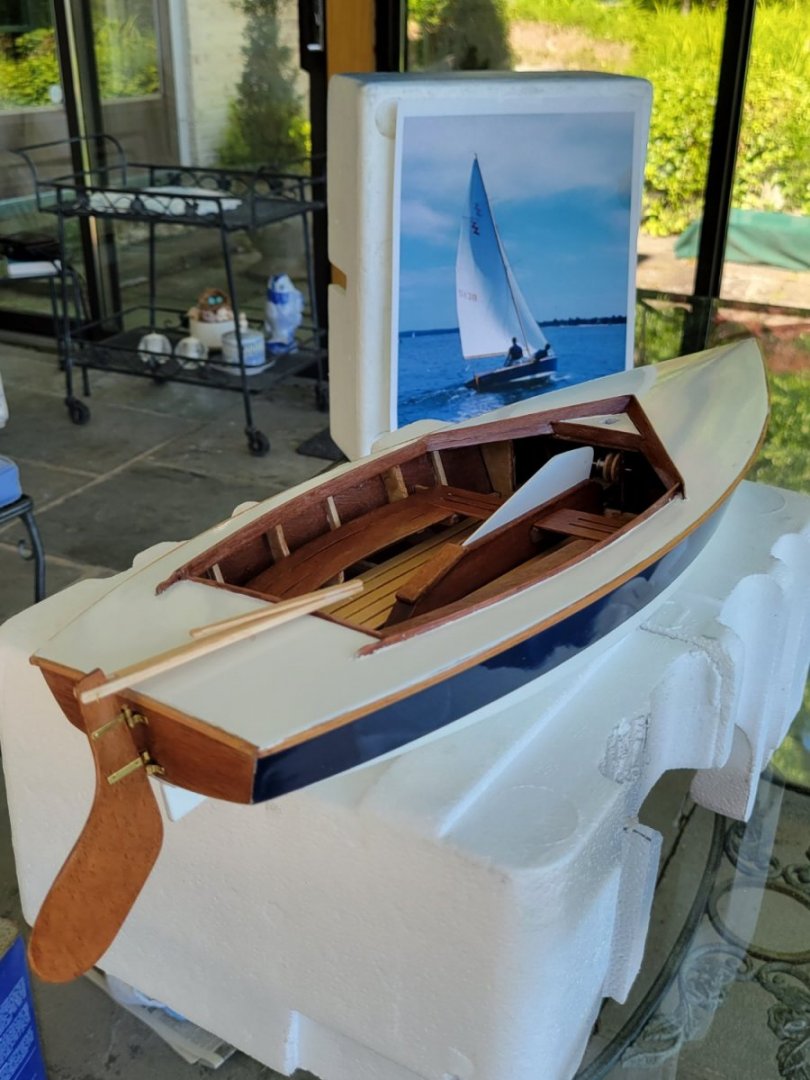
- berhard , wefalck , Paul Le Wol and 6 others
Beautiful job! It looks like the real thing.
That is absolutely stunning! I would love to see details about how you made the centerboard drum. That's something I've been puzzling over for quite some time now. And the rudder hardware looks especially excellent I must say!
Roger, Thank you very much for your comment. At this point I need a lot of encouragement.
Andrew, where is your finished model ? I have printed the pictures of the amazing hull that you made from the original plans. Have you gone further?
Thank you for your comments. I turned the drum and spool from cherry wood and then drilled the lightening holes. There is not a lot of room under the deck for the mechanism. I think the pintles and gudgeons on the rudder came from modlers central in Australia.

She is a beauty! Are there are areas where the deck is "rough" to provide non skid surface? Had this situation on an Islander 36 model many years ago and could not figure a way to do this to scale for a while. Finally came up with using powdered glass in the fiberglass molds where these areas were to be. The positives that came out of the mold were a perfect replication. I am sure a similar treatment could work on the positive versus the mold if you need to have such an area.
Again, your workmanship is great!
PLEASE take 30 SECONDS and sign up for the epic Nelson/Trafalgar project if you would like to see it made into a TV series. Click on http://trafalgar.tv There is no cost other than the 30 seconds of your time. THANK YOU
well done, looks great, keep up the good work. Love to sail a lighting again.
cheers. Peter Rumgay
Unfortunately it's been quite some time since I made any progress. I really have to be in the right head space to work on it, and I don't want to work on it just because I feel like I have to. Seeing your progress is a great inspiration though, so my motivation might be coming back soon. We shall see! I don't have access to a lathe or any kind of fancy tools like that, so if there's any chance you might be up to creating another one of those centerboard drums for me, I would be happy to pay you for your time and skill. Please feel free to private message me if that's something you would be willing to do.
Thank you for telling me about your method of achieving a realistic non-skid deck on your model.
Peter Rumgay used cotton cloth and paint on his beautiful model Lightning and it looks great . It is in keeping with the way Lightnings of that era were actually done.
I have been thinking about mixing some fine salt with paint. In the end I will probably just wet sand the deck and move on.
I think that I know what you mean about inspiration and competing interests. I am packing now to spend the Summer in Hood River, OR where I will see family and hopefully do some kiteboarding.
I am happy to turn you a drum/spool when I get back in September. The hard part was getting the specifications. The turning takes about an hour. I owe you big time for all the info I got from your blog. I will just have to get your address which I can do when I get back.
Best Wishes, Woody

On 6/11/2022 at 10:47 PM, Woody S said: It took many trys before I got the mirror finish on the topsides.
It certainly worked, looks beautiful.
Current Build:-
Cangarda (Steam Yacht) - Scale 1:24
Previous Builds:-
Schooner Germania (Nova) - Scale 1:36
https://modelshipworld.com/topic/19848-schooner-germania-nova-by-keithaug-scale-136-1908-2011/
Schooner Altair by KeithAug - Scale 1:32 - 1931
http://modelshipworld.com/index.php/topic/12515-schooner-altair-by-keithaug-scale-132-1931/?p=378702
J Class Endeavour by KeithAug - Amati - Scale 1:35 - 1989 after restoration.
http://modelshipworld.com/index.php/topic/10752-j-class-endeavour-by-keithaug-amati-scale-135-1989-after-restoration/?p=325029
Other Topics
Nautical Adventures
http://modelshipworld.com/index.php/topic/13727-nautical-adventures/?p=422846
- 3 months later...
The model of "Firefly" Lightning #5138 is in the final stages. I have been working hard on her since returning from Hood River, OR.
I still need to add the tiller extension and do a better job of coiling the lines, improving the boom vang, and then making a stand .
I thank all of you for your help along the way. I wish I had used the scale ribs as did Andrew instead of the Dumas kit plans. And the mahogany from the kit was not a good choice. Peter's model looks much better in cherry
I had a devil of a time figuring out the rigging. And I had to make many parts several times, because they kept breaking or getting lost on the floor. I could not find scale cleats and had to carve them out of wood. My craftsmanship did not do justice to the many small parts. But it was an enjoyable puzzle, and for me the boat looks very much like Firefly #5138.
Best wishes, Woody
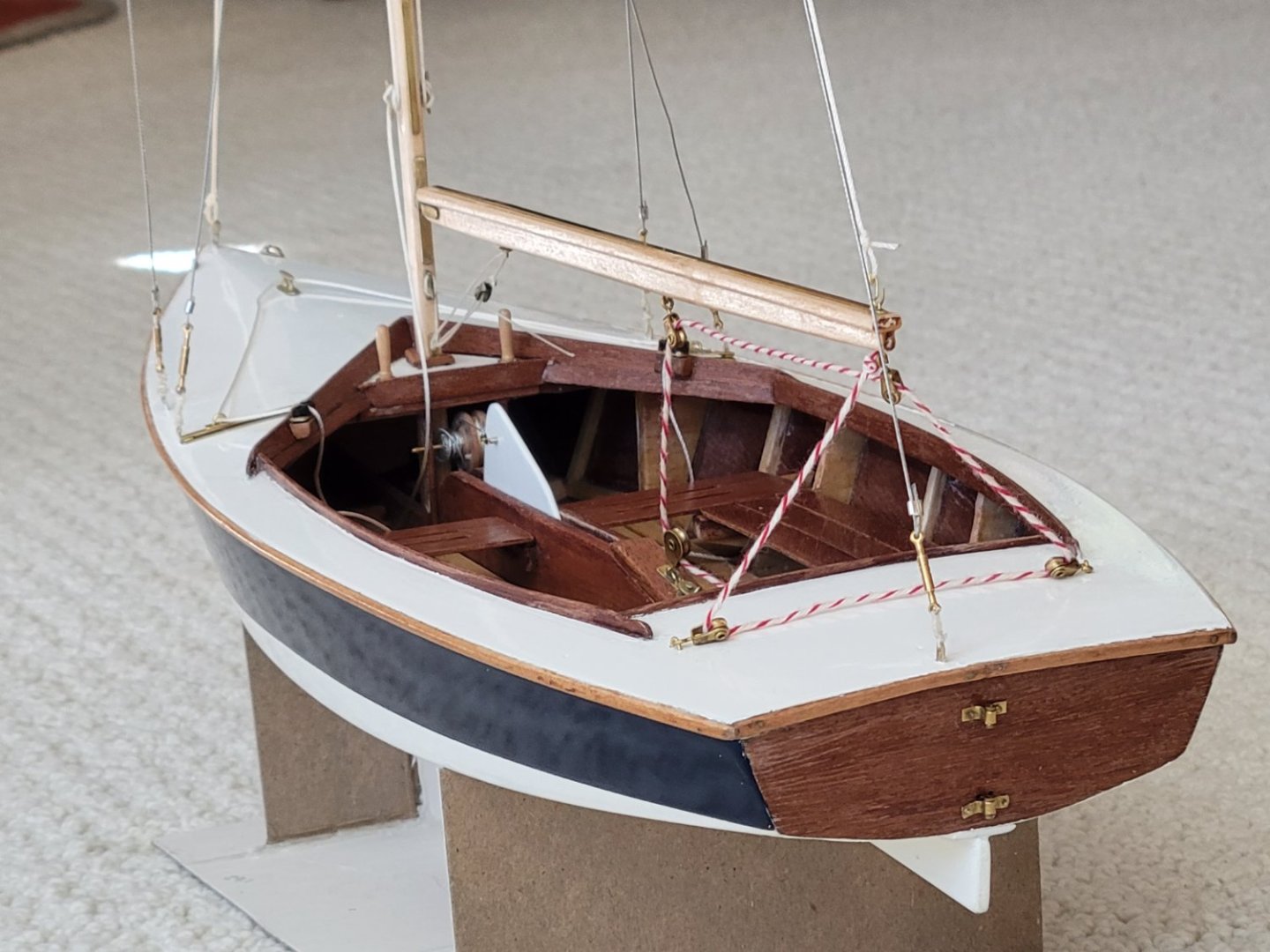
- Andrew J. , yvesvidal , berhard and 4 others
I feel like I should find a new adjective, but "absolutely stunning" is always the first thing that pops into my head when I see what you've created here. Looking forward to seeing what you do for a stand. I'm thinking of trying something with plexiglass or lexan, kind of like the display stand I got for my Lego Millennium Falcon, so it looks like it's just floating there.
I really appreciate the compliment from Andrew. I have not shown the model boat to my friends here, and it is nice to get feed back. I must say that I could do a better job on the next one. Building without plans is difficult.
I just ordered a display case from BlueJacket. I condidered plexiglass. It is less expensive and more contemporary. Contemporary models look very good under plexiglass. But in the end I chose cherry wood to match the other models that I have made. The measurements include the centerbosrd halfway down
The stand and cradle will be as simple as possible. I am working on the design. (Andrew , I have not forgotten your drum and spindle)
Oh, I did not try and make the deck non skid. Too many possible problems.
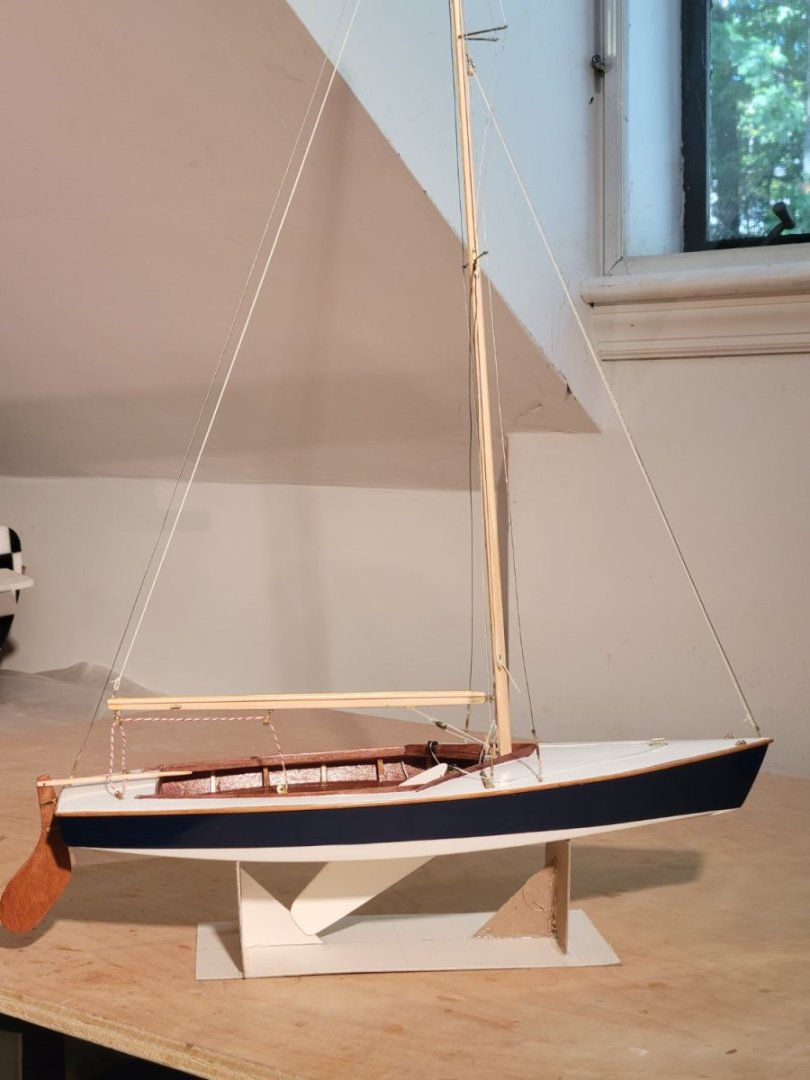
- gsdpic , Andrew J. , yvesvidal and 6 others
Join the conversation
You can post now and register later. If you have an account, sign in now to post with your account.

× Pasted as rich text. Paste as plain text instead
Only 75 emoji are allowed.
× Your link has been automatically embedded. Display as a link instead
× Your previous content has been restored. Clear editor
× You cannot paste images directly. Upload or insert images from URL.
- Insert image from URL
- Submit Reply
Recently Browsing 0 members
- No registered users viewing this page.
Modelshipworld - Advancing Ship Modeling through Research
SSL Secured
Your security is important for us so this Website is SSL-Secured
NRG Mailing Address
Nautical Research Guild 237 South Lincoln Street Westmont IL, 60559-1917
Model Ship World ® and the MSW logo are Registered Trademarks, and belong to the Nautical Research Guild (United States Patent and Trademark Office: No. 6,929,264 & No. 6,929,274, registered Dec. 20, 2022)
Helpful links.
- Articles Database
- NRG Home Page
- NRG Online Store
- Important: Our Guidelines
- Terms of Use
- Buildlog Index
About the NRG
If you enjoy building ship models that are historically accurate as well as beautiful, then The Nautical Research Guild (NRG) is just right for you.
The Guild is a non-profit educational organization whose mission is to “Advance Ship Modeling Through Research”. We provide support to our members in their efforts to raise the quality of their model ships.
The Nautical Research Guild has published our world-renowned quarterly magazine, The Nautical Research Journal, since 1955. The pages of the Journal are full of articles by accomplished ship modelers who show you how they create those exquisite details on their models, and by maritime historians who show you the correct details to build. The Journal is available in both print and digital editions. Go to the NRG web site (www.thenrg.org) to download a complimentary digital copy of the Journal. The NRG also publishes plan sets, books and compilations of back issues of the Journal and the former Ships in Scale and Model Ship Builder magazines.
Our Emblem ®
Nautical Research Guild ® and the NRG logo are Registered Trademarks, and belong to the Nautical Research Guild (United States Patent and Trademark Office: No. 6,999,236 & No. 6,999,237, registered March 14, 2023)
- Existing user? Sign In
- Latest Posts
- All unread content since my last vist
- Unread topics I have posted in
- Create New...
Great choice! Your favorites are temporarily saved for this session. Sign in to save them permanently, access them on any device, and receive relevant alerts.
- Sailboat Guide
Lightning is a 18 ′ 11 ″ / 5.8 m monohull sailboat designed by Sparkman & Stephens and built by Nickels Boat Works, Inc., Skaneateles Boat & Canoe Co., Helms - Jack A. Helms Co., Siddons & Sindle, Lippincott Boat Works, J.J. Taylor and Sons Ltd., Lockley Newport Boats, Eichenlaub Boat Co., Mobjack Manufacturing Corp., Clark Boat Company, Allen Boat Co., and Loftland Sail-craft Inc. starting in 1938.

Rig and Sails
Auxilary power, accomodations, calculations.
The theoretical maximum speed that a displacement hull can move efficiently through the water is determined by it's waterline length and displacement. It may be unable to reach this speed if the boat is underpowered or heavily loaded, though it may exceed this speed given enough power. Read more.
Classic hull speed formula:
Hull Speed = 1.34 x √LWL
Max Speed/Length ratio = 8.26 ÷ Displacement/Length ratio .311 Hull Speed = Max Speed/Length ratio x √LWL
Sail Area / Displacement Ratio
A measure of the power of the sails relative to the weight of the boat. The higher the number, the higher the performance, but the harder the boat will be to handle. This ratio is a "non-dimensional" value that facilitates comparisons between boats of different types and sizes. Read more.
SA/D = SA ÷ (D ÷ 64) 2/3
- SA : Sail area in square feet, derived by adding the mainsail area to 100% of the foretriangle area (the lateral area above the deck between the mast and the forestay).
- D : Displacement in pounds.
Ballast / Displacement Ratio
A measure of the stability of a boat's hull that suggests how well a monohull will stand up to its sails. The ballast displacement ratio indicates how much of the weight of a boat is placed for maximum stability against capsizing and is an indicator of stiffness and resistance to capsize.
Ballast / Displacement * 100
Displacement / Length Ratio
A measure of the weight of the boat relative to it's length at the waterline. The higher a boat’s D/L ratio, the more easily it will carry a load and the more comfortable its motion will be. The lower a boat's ratio is, the less power it takes to drive the boat to its nominal hull speed or beyond. Read more.
D/L = (D ÷ 2240) ÷ (0.01 x LWL)³
- D: Displacement of the boat in pounds.
- LWL: Waterline length in feet
Comfort Ratio
This ratio assess how quickly and abruptly a boat’s hull reacts to waves in a significant seaway, these being the elements of a boat’s motion most likely to cause seasickness. Read more.
Comfort ratio = D ÷ (.65 x (.7 LWL + .3 LOA) x Beam 1.33 )
- D: Displacement of the boat in pounds
- LOA: Length overall in feet
- Beam: Width of boat at the widest point in feet
Capsize Screening Formula
This formula attempts to indicate whether a given boat might be too wide and light to readily right itself after being overturned in extreme conditions. Read more.
CSV = Beam ÷ ³√(D / 64)
One of the most popular one-design classes in the US since the 1940’s. But fleets also exist in other parts of the world. Although originally designed for wood planked construction, nearly all boats since the early 1960’s have been built of fiberglass. Ballast above is max weight of centerboard.
Embed this page on your own website by copying and pasting this code.
- About Sailboat Guide
©2024 Sea Time Tech, LLC
This site is protected by reCAPTCHA and the Google Privacy Policy and Terms of Service apply.

Login to my account
Enter your e-mail and password:
New customer? Create your account
Lost password? Recover password
Recover password
Enter your email:
Remembered your password? Back to login
Your cart is empty

Lightning Model Kit
Description.
This is one of the most popular kits we have ever offered. It might be because it is pretty simple to build, or that it's a handsome boat. But because so many folks order two, we think it is because they are so much fun to race.
Made with precision pre-cut balsa frames and mahogany planking, the kit includes plans, thorough instructions, nylon sails, line for rigging, and hardware. Plus it has a lead weight which you attach to the bottom of the centerboard if you are going to sail it.
This Lightning scale replica is a great way to learn about boats, without having to spend the time on precise cutting. You supply the varnish, paint, glue, and a few household tools, everything else is included. Designed for sailing on your favorite "golden pond" or as a handsome addition to your mantelpiece. Couple of building tips: clothespins make great clamps, and styrofoam (not the corn-starch based type) peanuts make great flotation under the foreward and aft decks. This model is not designed for remote control. If you sail on a larger pond and don't have a chase boat, kite string/spool are very handy.
Scale: 1" =1' LOA: 19" Beam: 6 1/2" Height: 26" Note: that stand in the photo isn't included... we made that in just a few minutes from scrap wood. You'll likely make something prettier!
Skill Level = 1
Skill levels are: 1 = beginner 2 = intermediate 3 = advanced
If you'd like a better understanding of just what you are getting yourself in for, click: INSTRUCTIONS.
You'll supply paint, and simple household tools:
Razor / X-acto knife, ruler, wood glue, super glue, Course, Medium, and Fine grit sandpaper, small paint brush, masking tape, 3/32" drill bit, needle, thread, pliers and cutting pliers, pins, clothespins for clamps.

Customer Reviews
My son and I built this boat(he mostly watched). Very fulfilling, nice kit, he sails it in the pool. Money/time well spent!
I bought this for my brother, and he loves it. He said it is way better than the plastic models he’s done lately, getting more involved with shaping and sanding the pieces. The quality of the materials and intimacy of the directions feels like he’s building with the producer, not a faceless company. I’m betting he gets more kits in the future!
Very nice kit!
I like the kit. It is very complete. The instructions are good, but require a lot if flipping back and fourth between the text and the diagrams. I started off using cyanoacrylate glue, that was a mistake. Now I’m using wood glue and the build is going much better. I am about half way. It is a fun model to build. Mine will be painted to match the Lightning I once had, 13703.
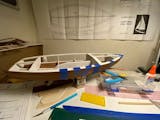
I have built many wooden boat models over the years but haven’t done so for about 10 years. This is a great starter, just read through the instructions first and take your time.
Recently viewed
Our Store is in Brooklin, Maine
at 84 Great Cove Drive. We're open Mon-Fri 8am to 4:30 pm Call 1.800.273.7447. WE'RE RIGHT HERE .
Timely Shipping
We are 99-3/4% sure... that we will ship your order within 24 hours Granted, that does not include weekends and holidays.
Secure payments
Rest assured... not only is our site secure, we do not hold your credit card/payment info.
- Opens in a new window.
Lightning Sailboat 19 Kit
This 1" to 1' scale replica of the Lightning class boat also makes a beautiful display model for your office or living room. The kit is made up of plywood frames and handsome mahogany planking. Nylon sails add the finishing touch to this kit.
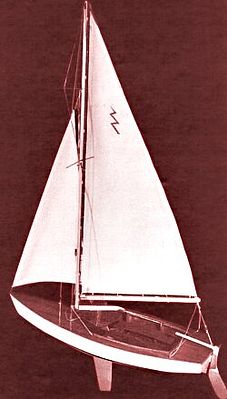
| ADD TO CART | WISH LIST |
| Retail $80.00 SAVE 21% ! | Item # dum1110 |
Spotlight Review
Member gallery.
You Might Also Like
- Length 19 inches
- Beam 6-1/2 inches
- Mast 26 inches
- Sail Control Unit Not designed for radio control
- Dumas Product Number: 1110
Requirements & Suggestions
Product Rank
Others Also Ordererd
Save 25% Dust Collection Hoses & Fittings
Your Cart is Empty
Have an account?
Log in to checkout faster.
You may also like
Dumas Products Inc
Lightning Sailboat Model Kit
Ships from Manufacturer
Shipping & Returns
- Combination of laser cut and die cut wooden parts for quality fit
- Nylon sails and rigging
- Step-by-step instructions
- Length 19" x Beam 6-1/2" x Mast 26"
- Skill Level: Introductory Beginner some building experience helpful
Shipping / Billing Information
This product ships direct from the manufacturer:
- Your order will ship in approximately 5 business days.
- This product is considered special order. Your account will be charged when you place your order.
- Express or overnight shipping is not available for this product.
- Ships by Ground to the 48 contiguous states. Cannot ship to Alaska, Hawaii, PO Boxes, APOs, US Territories, Canada or other foreign countries.
Return Information
Warranty Information
Compare With
- Choosing a selection results in a full page refresh.
Favorite Your Store
Form field Zip or City is required. Please fill out the value.
Favorite Store
Hours of Operations
Dumas Products
Serving the model hobby industry since 1947. Office hours Monday-Thursday 7:30 am – 4:00 pm MST. Closed Friday-Sunday.

Plans & Inst.-Kit #1110-Lightning
Description.
Plans & Instructions for Kit #1110-Lightning
**Please Note** Plans are not suited for scratch build.
Related products

Plans & Inst.-Kit #1225-Victory Tug

Plans & Inst.-Kit #1218-USS Crockett

Plans & Inst.-Kit #1213-American Enterprise

Plans & Inst.-Kit #1214-USCG 41′ Utility
International Lightning Class Association
Class contact information.
Click below
Class Email
Class Website
One-Design Class Type: Dinghy
Was this boat built to be sailed by youth or adults? Both
Approximately how many class members do you have? 1600
Photo Credit:Douglas Wake

Photo Credit: Art Petrosemolo
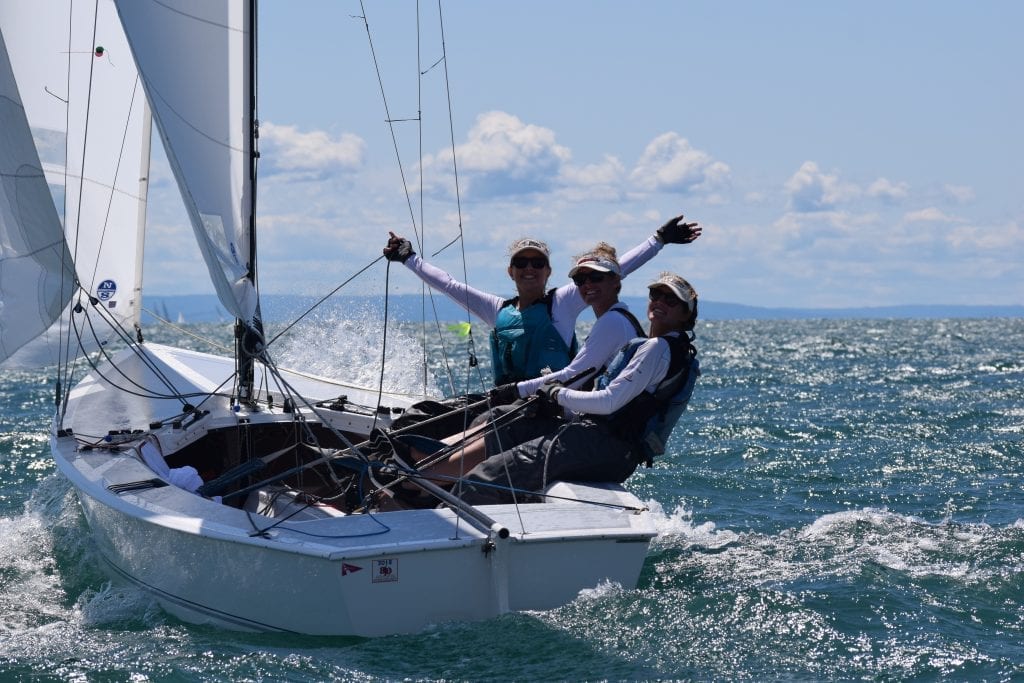
About International Lightning Class Association
The Lightning truly excels as an affordable racing boat. The rig is simple but offers sophisticated sail shape controls. The hull features a unique hard chine design that combines the stability that provides sail-carrying power, with flat bottom sections that promote planing. At 700 pounds all up, the trailerable centerboard sloop is tough enough to avoid frequent breakdowns, but light enough to plane wildly on the reaches. Membership is diverse with sailors aged 8 to 80+. Many families sail together at top events and it is common to see females make up at least 40% of competitors.
The Lightning is sailed in more than thirteen countries and in the Pan American Games. A World, Master World and Youth World Championships are held every two years. North American, South American and European Championships are held each year as are innumerable regional and District championships. Major regattas attract some of the finest sailors in the world, but you find Class members friendly and the sailmakers’ complete tuning guides helpful at getting you up to speed in a hurry.
The International Lightning Class Association is one of the oldest and best organized class associations in sailboat racing. Its primary purpose is to serve its membership, preserve the integrity of the Lightning and provide high-quality competitive events. In addition, the Lightning Class publishes monthly e-blasts and a quarterly newsletter Flashes with up-to-date regatta news, boat brokerage and ideas on how to get the most out of your Lightning. The professionally managed association and dedicated volunteers are always on hand to assist both current and potential members.
If you’re looking for a boat you can be proud to sail, one that offers dinghy handling with the performance of a sport boat, a refined design that’s free of fads, complete with the technology of today for both racing and day sailing – look at the Lightning.
Boats Produced: 15630+
Class boat builder(s):
Allen Boat Company, Buffalo, NY: https://www.allenboatco.com/
WindRider International: https://www.windrider.com/
Approximately how many boats are in the USA/North America? 11,000+
Where is your One-Design class typically sailed in the USA? List regions of the country:
East of the Mississippi, Mid-West, Texas, Denver, San Diego, Pacific Northwest Click Here for Fleet Finder Map: https://www.lightningclass.org/content.aspx?page_id=451&club_id=93488
Does this class have a spinnaker or gennaker? Yes
How many people sail as a crew including the helm? 3
Ideal combined weight of range of crew: 490
Boat Designed in 1938
Length (feet/inches): 19’0″
Beam: 6’6″
Weight of rigged boat without sails: 700 lbs
Draft: (board down): 4’11”, (board up): 5″
Mast Height: 26’2″
Back to One-Design Central
Copyright ©2018-2024 United States Sailing Association. All rights reserved. US Sailing is a 501(c)3 organization. Website designed & developed by Design Principles, Inc. -->
Marine Lightning Protection
- Introduction
- Sideflashes
- The lightning system
- Collaboration
- Air terminals
- Grounding concepts
- Grounding guide
- Design & build
- Connections
- Grounding Strips
- Siedarc TM Electrodes




















IMAGES
COMMENTS
Lightning Sailboat 19' build Discussion in ' Boat Design ' started by FirstLight, Aug 21, 2012 .
Credits: Photos taken by the builder of #15219 Armando Trivero
Lightning. The Lightning is a recreational sailboat, initially built with wooden plank construction and, since the early 1960s, of fiberglass with wood trim. It has a fractional sloop rig with wooden or aluminum spars. The rig employs a backstay, anchored off center, so as to not impede the tiller.
Building the Lightning sailboat model (by Dumas) I'm currently building a Lightning wooden sailboat model. This is my first time building a model of this sort, and for my grandson, who's building the same model in step with my build, it's his first time ever working with tools and his hands. Needless to say, we could use a little advice ...
The Lightning, a 19-foot trailerable centerboard sloop, was originally designed by Sparkman & Stephens as an affordable family day-sailor and racing boat. She has evolved into one of the most popular
I have been inspired by Andrew J's Lightning experience building first a Kit and then from scratch. My children learned to sail in the 1960's on Lightning #5138. I would like to create a model of that sailboat. I have built scratch models of 1850's schooners before. But on this project I decided ...
Re: Lightning Class build ...which show a boat built completely different from the way Prudence is put together. Prudence is single planked the long way, rather than multiple diagonal plys across the bottom.
Lightning is a 18′ 11″ / 5.8 m monohull sailboat designed by Sparkman & Stephens and built by Clark Boat Company, Lippincott Boat Works, Nickels Boat Works, Inc., Allen Boat Co., Helms - Jack A. Helms Co., J.J. Taylor and Sons Ltd., Lockley Newport Boats, Skaneateles Boat & Canoe Co., Mobjack Man...
The Lightning is one of the most popular kits we have ever offered. It might be because it is pretty simple to build, or that it's a handsome boat.
Lightning Sailboat 19 Kit This 1" to 1' scale replica of the Lightning class boat also makes a beautiful display model for your office or living room. The kit is made up of plywood frames and handsome mahogany planking. Nylon sails add the finishing touch to this kit. (4) Dumas # dum1110
Complete plans for building a Lightning. Entitles you to build one Lightning boat and to have an official ILCA number assigned to your hull. Included is a copy of the Wooden Boat Magazine article and Hamlin & Smith supplement plans, as well as the original Sparkman & Stephens plans. Price: $100.00 — Boat Number.
Buy the Dumas Products Inc Lightning Sailboat Model Kit for sale online from Woodcraft. Visit us to order online or find your local Woodcraft store today!
One of the most popular one-design classes in the US since the 1940's. But fleets also exist in other parts of the world. Although originally designed for wood planked construction, nearly all boats since the early 1960's have been built of fiberglass. Ballast above is max weight of centerboard.
Plans & Instructions for Kit #1110-Lightning **Please Note** Plans are not suited for scratch build.
The International Lightning Class Association protects the boat's design and licenses custom and private builders to build boats under its administration. A list of Lightning builders is available from the ILCA upon request.
The International Lightning Class Association is one of the oldest and best organized class associations in sailboat racing. Its primary purpose is to serve its membership, preserve the integrity of the Lightning and provide high-quality competitive events. In addition, the Lightning Class publishes monthly e-blasts and a quarterly newsletter ...
Sailboat The distinctive feature in a sailboat is the pre-existing lightning rod that carries the sails. If the mast is aluminum it can be used as a main down conductor, although it is advisable to add an air terminal at the masthead for protection of transducers.
All royalties for many of the boat's components, including the hull, mast, and sails go to the International Lightning Class Association, who also regulates the design and the Class activities.
Preventing damage when sailing in lightning A lightning protection system (LPS) is designed to divert lightning energy to ground (in this case the sea), in such a way that no damage occurs to the boat or to people. Ideally, this also includes protecting a boat's electrical and electronic systems, but marine electronics are sensitive and this level of protection is hard to achieve. Lightning ...
by Bill Oben The Lightning sailboat was designed by the Naval Architectural firm of Sparkman & Stephens in response to a request from John and George Barnes, owners of Skaneateles Boats, Inc. The Barnes brothers were interested in building a one-design sailboat which could be used both for racing as well as family day sailing. The two firms collaborated closely on the design of the sailboat ...
The Lightning's lineage begins in 1876 with the formation of Bowdish and Company. Bowdish quickly developed a reputation for building fine small steam launches, rowboats, canoes, and sailing canoes. In 1890 a young boatwright named George Smith joined the company. In 1893, Smith and his partner, James Ruth purchased Bowdish and Company and renamed it the Skaneateles Boat and Canoe Company. At ...